September 22, 2025

This article presents a compelling overview of positive and negative reinforcement techniques in behavior management, illustrating their significant impact on influencing behavior across various settings. It highlights specific strategies such as token economies and escape conditioning, which have proven effective in enhancing engagement and compliance among learners. By detailing these practical applications, the article underscores the effectiveness of reinforcement methods in both educational and behavioral contexts, inviting readers to reflect on how these strategies can be implemented in their own practices.
Understanding the dynamics of behavior management is crucial, particularly through the effective application of reinforcement strategies, both positive and negative. These methods not only shape individual actions but also cultivate an environment that promotes learning and growth.
Consider the impact of various reinforcement techniques, such as token economies and escape conditioning; they can significantly influence behavior in educational and professional settings. Yet, a pressing challenge persists: how can one effectively balance these strategies to maximize positive outcomes while avoiding the inadvertent encouragement of avoidance behaviors?
This question invites reflection on current practices and the potential for improvement.
Hire ABA is transforming the recruitment landscape for Board Certified Behavior Analysts (BCBAs) in a rapidly expanding job market. With projections indicating a significant rise in demand for BCBAs—expected to grow by approximately 22% to 23% over the next decade—it's crucial to engage with a platform that understands these dynamics. Hire ABA offers tailored job matching services that connect candidates with positions suited to their expertise in Applied Behavior Analysis (ABA) therapy.
Our personalized resume assessments accurately evaluate your experience and career goals, allowing us to match you with the best roles. By utilizing advanced job fit scoring, we identify opportunities that align with your skills, preferences, and desired locations. This streamlined approach enhances the job-seeking experience for candidates and helps employers efficiently find qualified professionals.
As noted by the Behavior Analyst Certification Board, 'the demand for BCBAs continues to outpace many other professions, making it an attractive and sustainable career choice for those interested in behavioral health and autism interventions.' Are you struggling to find the right candidates? By ensuring better alignment between job seekers and employers, Hire ABA plays a crucial role in fostering a more effective hiring process in the ABA therapy sector. Employers can leverage Hire ABA's platform to access a pool of qualified candidates, ensuring they find the right fit for their needs. Take action now to with Hire ABA.
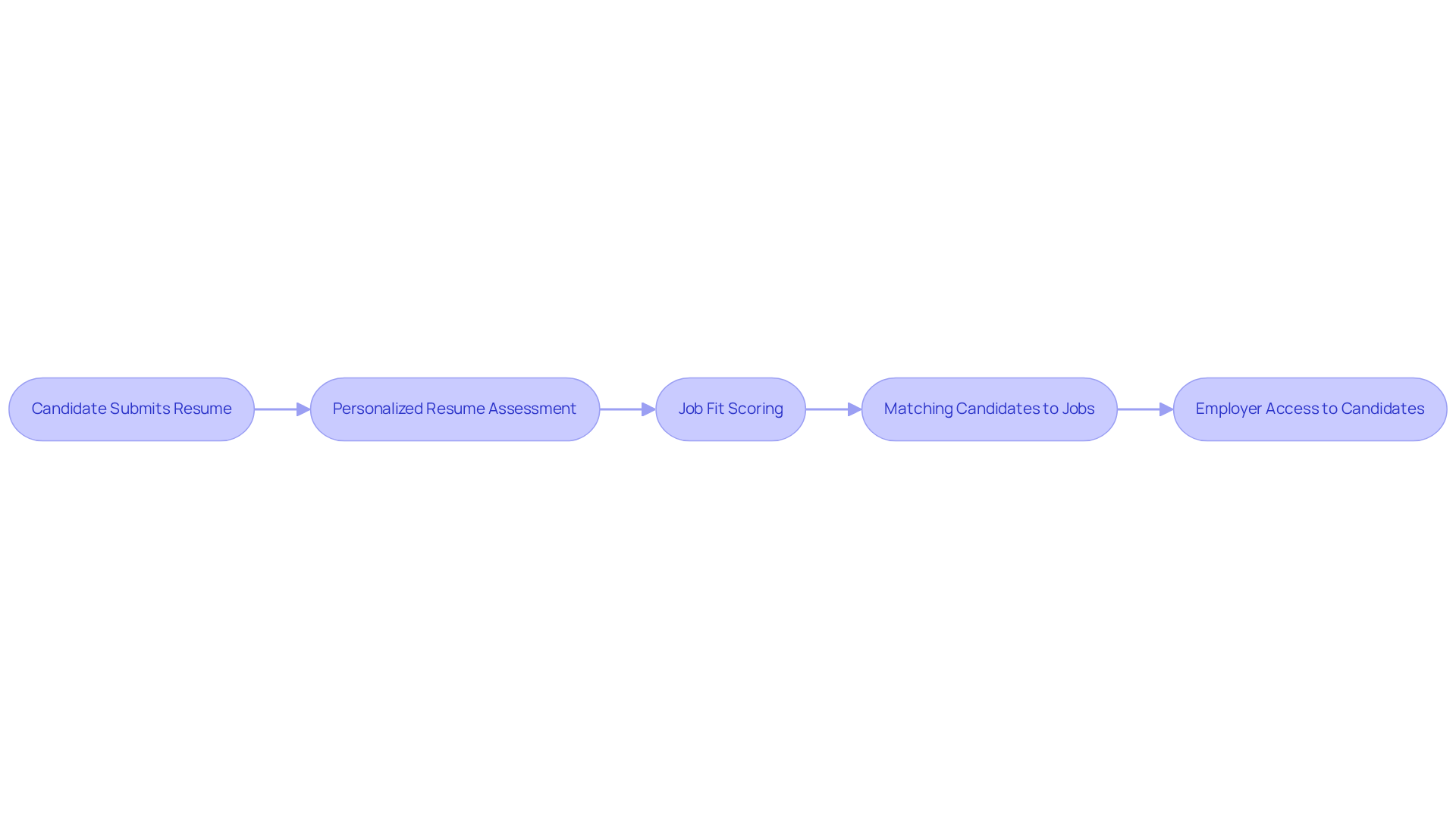
Token economy systems represent organized reinforcement methods that illustrate positive and negative reinforcement examples by rewarding individuals with tokens for exhibiting preferred actions. These tokens can be exchanged for tangible rewards, such as toys or privileges, establishing their power as tools within educational environments. Research reveals that well-designed token economies can significantly enhance learner engagement and motivation, with studies indicating that they can increase desired behaviors by up to 80%. Moreover, effectively implemented token systems can reduce disruptive incidents by 25-65%. For instance, 81% of educators who adopted token economies during remote learning noted their critical role in sustaining learner engagement.
Effective implementation necessitates clear expectations, immediate feedback, visual tracking of progress, and positive and negative reinforcement examples, all of which collectively amplify the system's impact. Expert opinions highlight the necessity of customizing token economies to meet individual needs, ensuring that positive and negative reinforcement examples align with students. Token economies that focus on yield optimal outcomes, while family participation in reward selection can further enhance engagement. This adaptability is vital, as it cultivates a positive learning environment and encourages sustained behavioral improvements over time. Notably, token economies can enhance academic performance measures by 15-30%, underscoring their effectiveness within educational contexts.
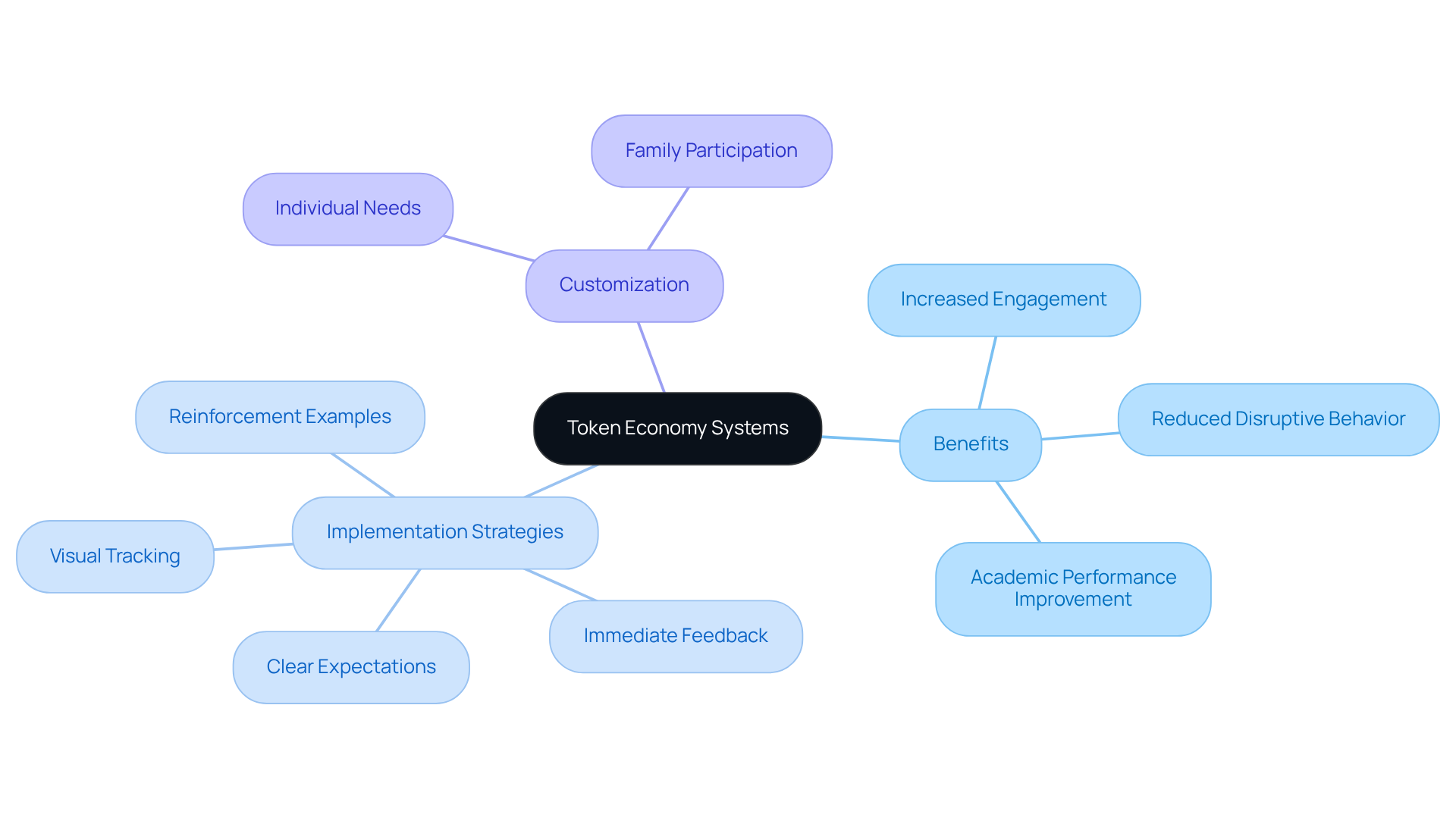
Escape conditioning methods empower individuals to evade or flee from unpleasant circumstances by engaging in specific actions. For instance, a student may exit a noisy classroom upon completing their work quietly. This approach , effectively influencing future compliance and enhancing task engagement.
Recent studies underscore the efficacy of escape conditioning in educational settings, revealing that students benefit from breaks after finishing challenging assignments, which alleviates stress and has been shown to improve compliance while reducing disruptive behaviors. Behavior specialists emphasize that such strategies not only promote positive actions but also foster a supportive learning environment.
As noted by Athens and Vollmer, the implementation of negative encouragement strategies in classrooms has led to increased compliance rates and a reduction in behavioral issues. Notable positive and negative reinforcement examples of escape conditioning include:
These examples illustrate how these techniques can effectively manage behaviors while minimizing stress and discomfort. However, it is essential to exercise caution regarding excessive reliance on negative reinforcement, as it may lead to avoidance behaviors and unintended consequences. Acknowledging that escape is a predominant function of disruptive behaviors in children can further enhance the application of these techniques.
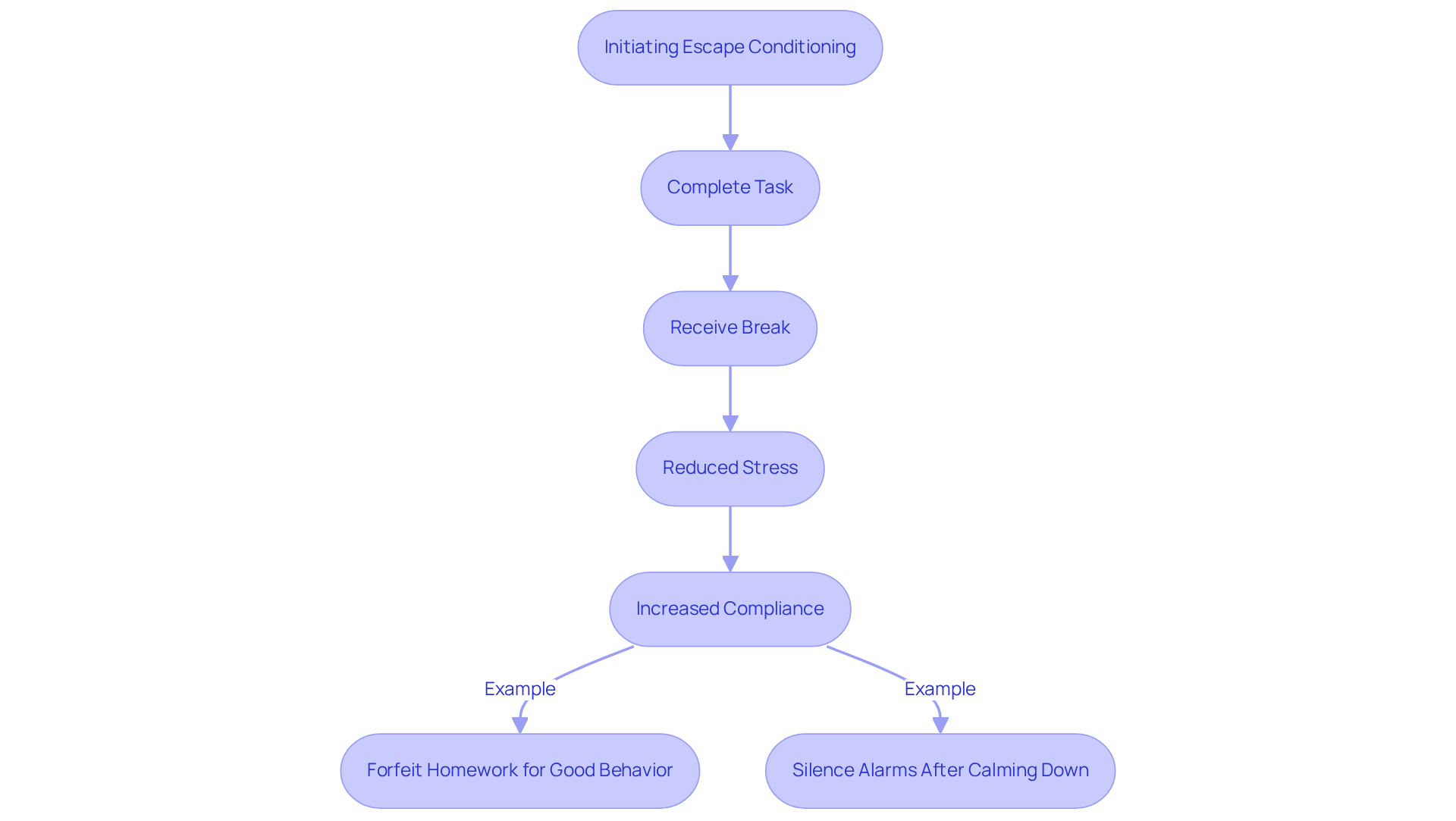
In educational environments, it is essential for educators to effectively utilize praise and rewards as positive and negative reinforcement examples to encourage positive behaviors among learners. Research by Paul Caldarella from Brigham Young University indicates that learners are up to 30% more concentrated on tasks when educators employ positive encouragement strategies.
For instance, when an individual correctly answers a question, an instructor might respond with enthusiastic praise, such as 'Great job!' or offer a small reward like extra playtime. This prompt encouragement is one of the that not only enhances the learner's confidence but also significantly increases their likelihood of engaging actively in upcoming classroom activities.
As Caldarella states, 'Behavior that is reinforced tends to increase.' Such practices foster a nurturing learning atmosphere, ultimately improving educational experiences and outcomes for learners.
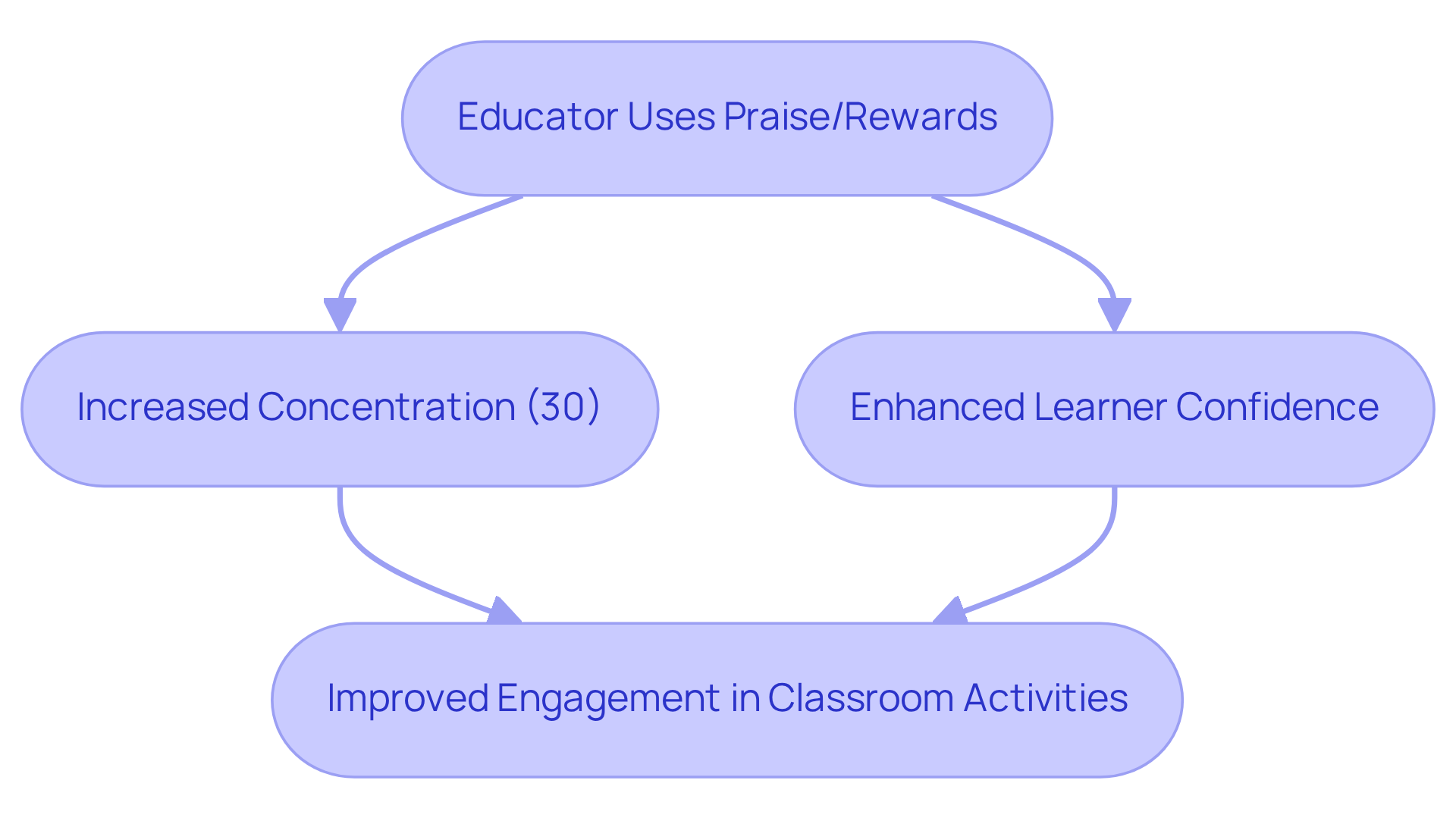
An illustration of positive and negative reinforcement examples is when learners are allowed to evade an undesirable task, such as a quiz, if they demonstrate consistent positive conduct throughout the week. By removing this unpleasant task, students are motivated to sustain their constructive actions, providing that reinforce adherence and minimize disruptive behavior.
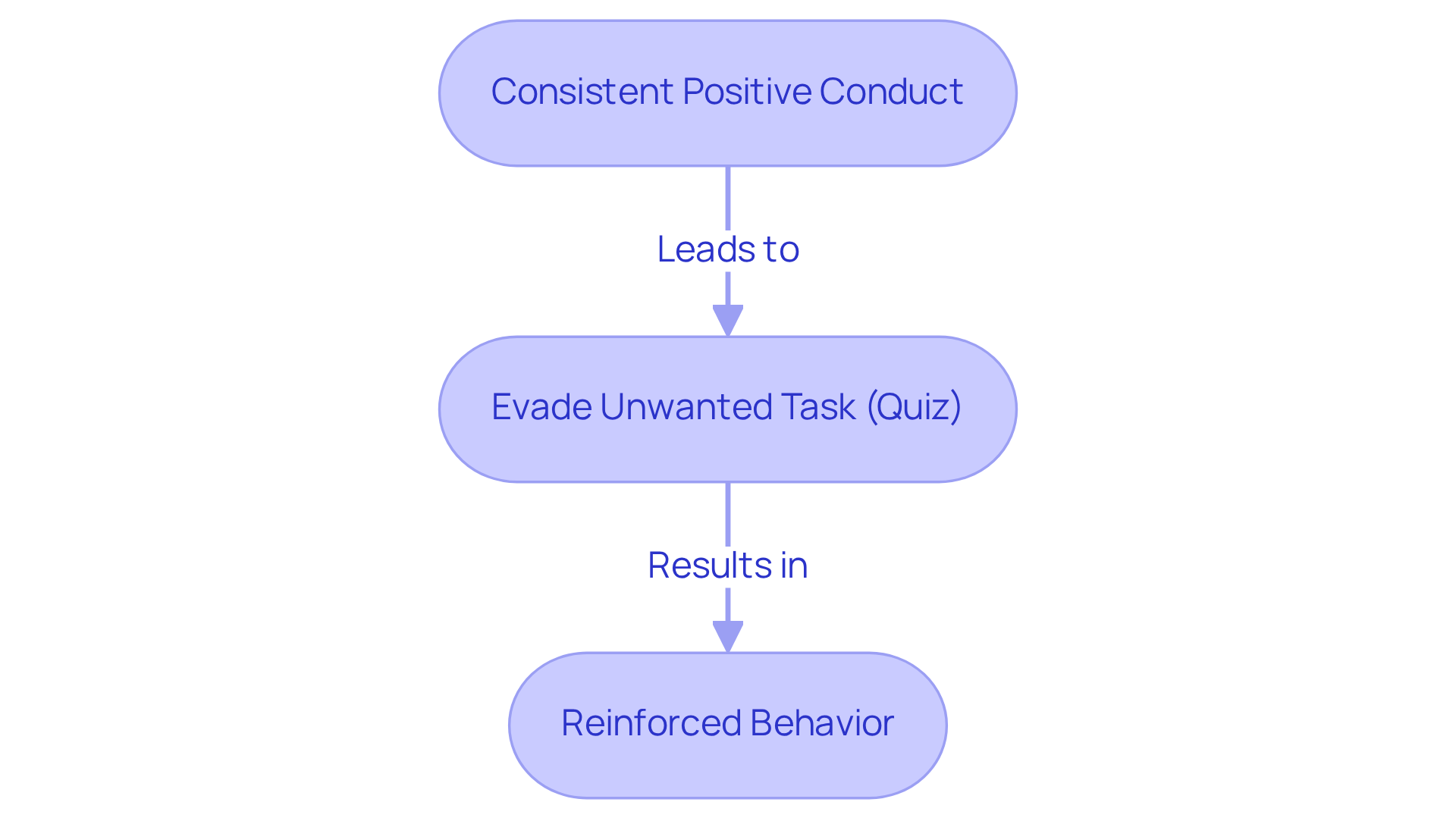
Family reward systems can be seen as effective strategies to promote positive behaviors in children, which are illustrated through positive and negative reinforcement examples. One effective method is the implementation of a sticker chart, where children earn stickers for completing tasks such as chores or homework.
By customizing the chart with vibrant colors, engaging themes, or beloved characters, parents can significantly enhance children's motivation. This visual representation of progress not only incentivizes children but also fosters a sense of responsibility and accomplishment. As children observe their charts filling up, they receive immediate feedback, reinforcing their efforts and encouraging continued engagement.
To ensure that goals remain attainable, it is essential to break tasks down into manageable steps. Upon accumulating a predetermined number of stickers, children can exchange them for simple, like a family outing or a special treat, further boosting their motivation.
Research indicates that positive and negative reinforcement examples can profoundly influence children's actions, cultivating a culture of accountability and success. By involving children in the setup process and allowing them to select their rewards, parents can enhance their sense of ownership and pride in their achievements, ultimately leading to improved behavior and learning outcomes.
Consistency in utilizing the sticker chart is vital for its success, as it ensures that children comprehend expectations and remain actively engaged.
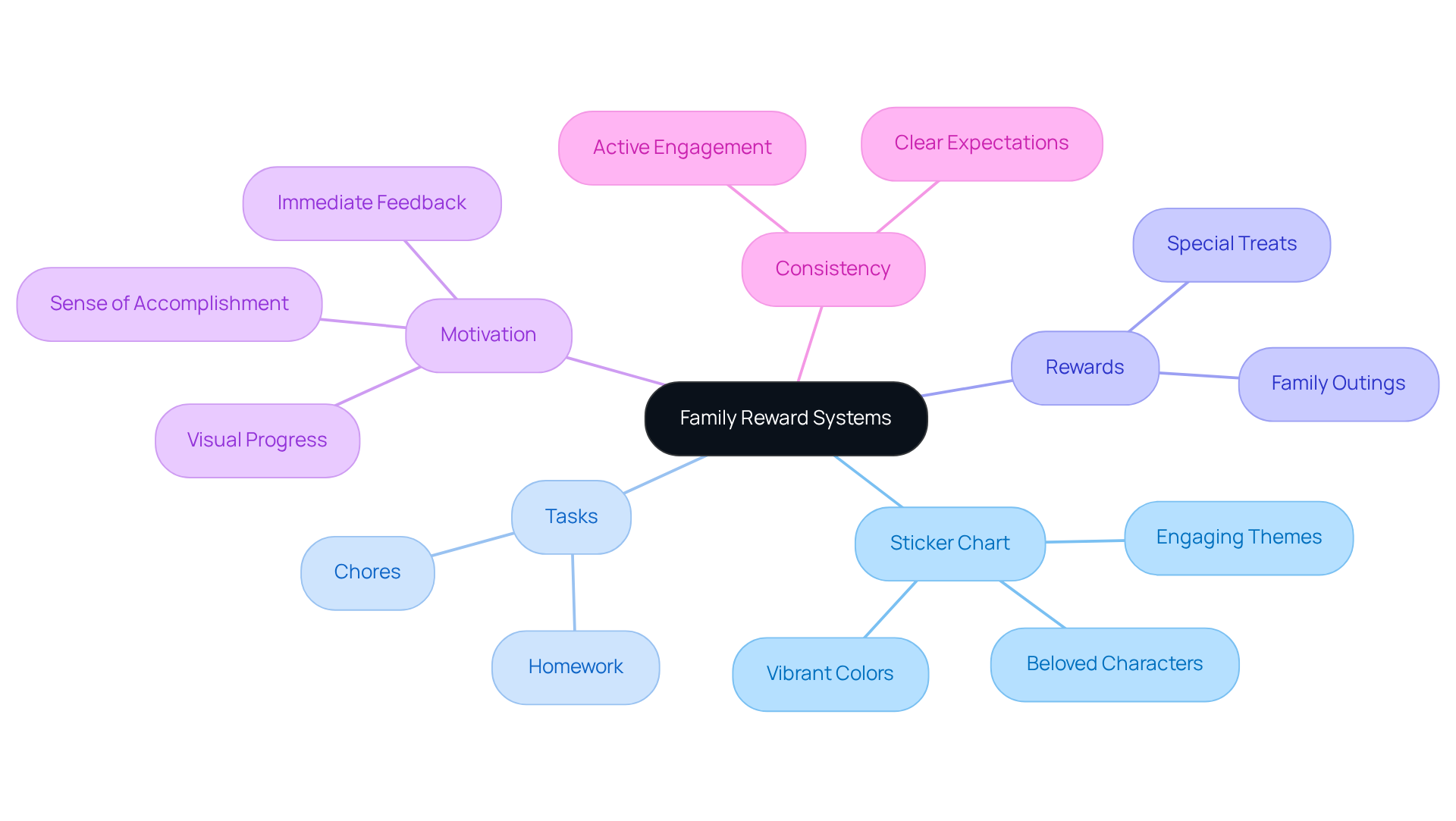
[Flexible work arrangements](https://zoetalentsolutions.com/flexible-work-arrangements) illustrate significant advantages by alleviating the stress associated with rigid schedules. For instance, can be seen when an employee who consistently meets deadlines is rewarded with the option to work from home or adjust their hours. This flexibility not only boosts job satisfaction—working from home made people 67% happier—but also fosters a culture of high performance.
Employees are motivated to sustain their productivity by understanding positive and negative reinforcement examples in order to continue enjoying these benefits. Research indicates that:
By creating an environment where employees feel valued and empowered, organizations can enhance overall performance and satisfaction. Engaged workplaces experience 41% less absenteeism, further underscoring the beneficial impact of flexible work on workplace dynamics.
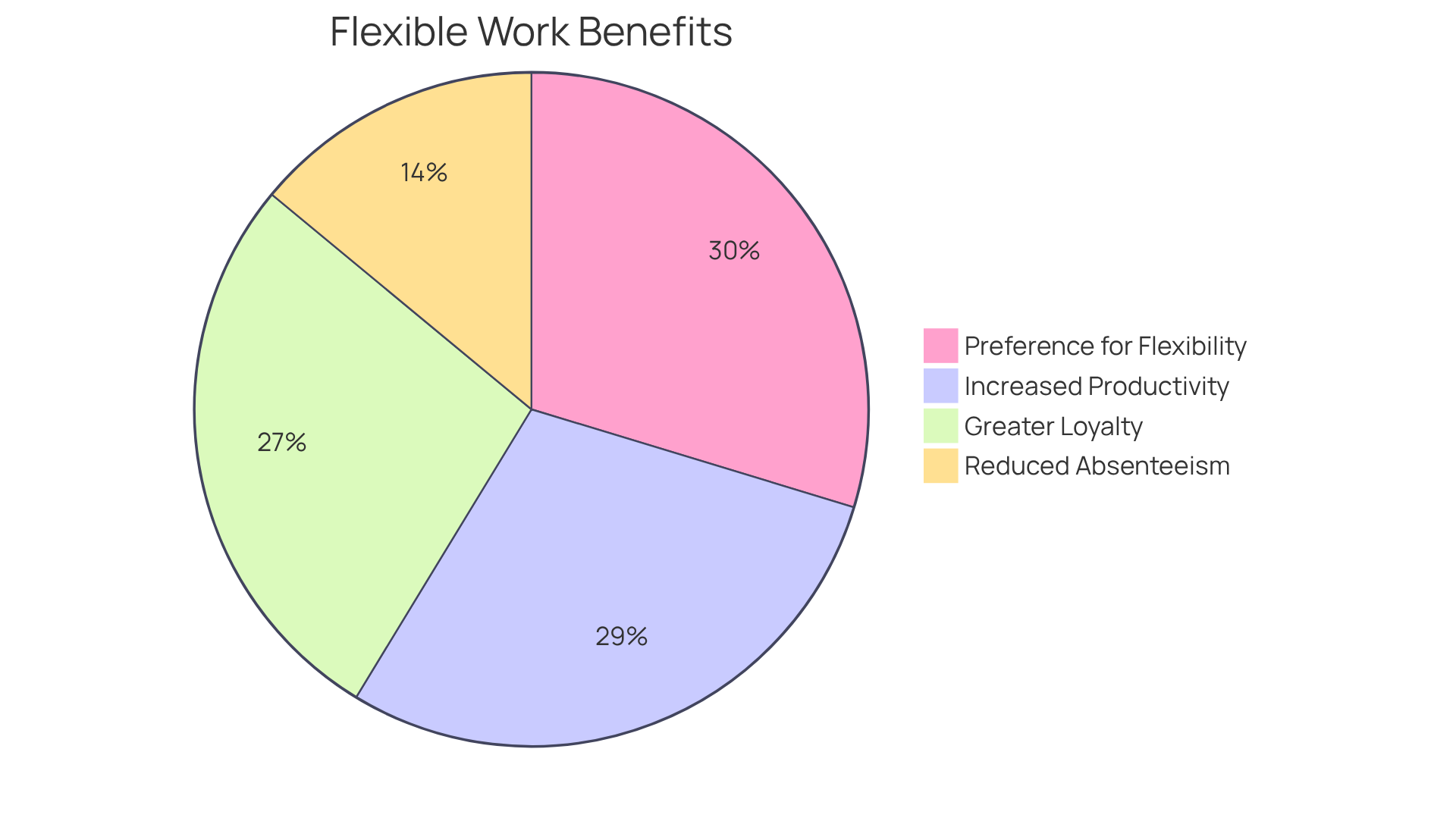
In the realm of sports, performance bonuses are strategically linked to specific achievements, such as reaching a predetermined number of points or securing a championship title. For instance, an athlete might earn a bonus for scoring 20 goals in a season. This financial incentive serves as a robust form of encouragement and is one of the that motivate athletes to strive for excellence and enhance their performance.
Research indicates that such incentives can significantly enhance motivation; many athletes report increased focus and determination when financial rewards are at stake. Experts suggest that positive and negative reinforcement examples serve to not only encourage athletes to meet their goals but also foster a competitive spirit that can lead to improved overall performance.
As José Álvarez, a psychologist, observes, 'Positive and negative reinforcement examples show that positive encouragement has the power to strengthen and increase the likelihood that a desired behavior will be repeated.'
Furthermore, as the landscape of athlete compensation evolves, understanding the motivational impact of financial incentives remains crucial for both athletes and coaches aiming to maximize potential. The process of enhancement is continuous; athletes must stay dedicated to their objectives, and positive encouragement cultivates a motivating and supportive atmosphere that aids their growth.
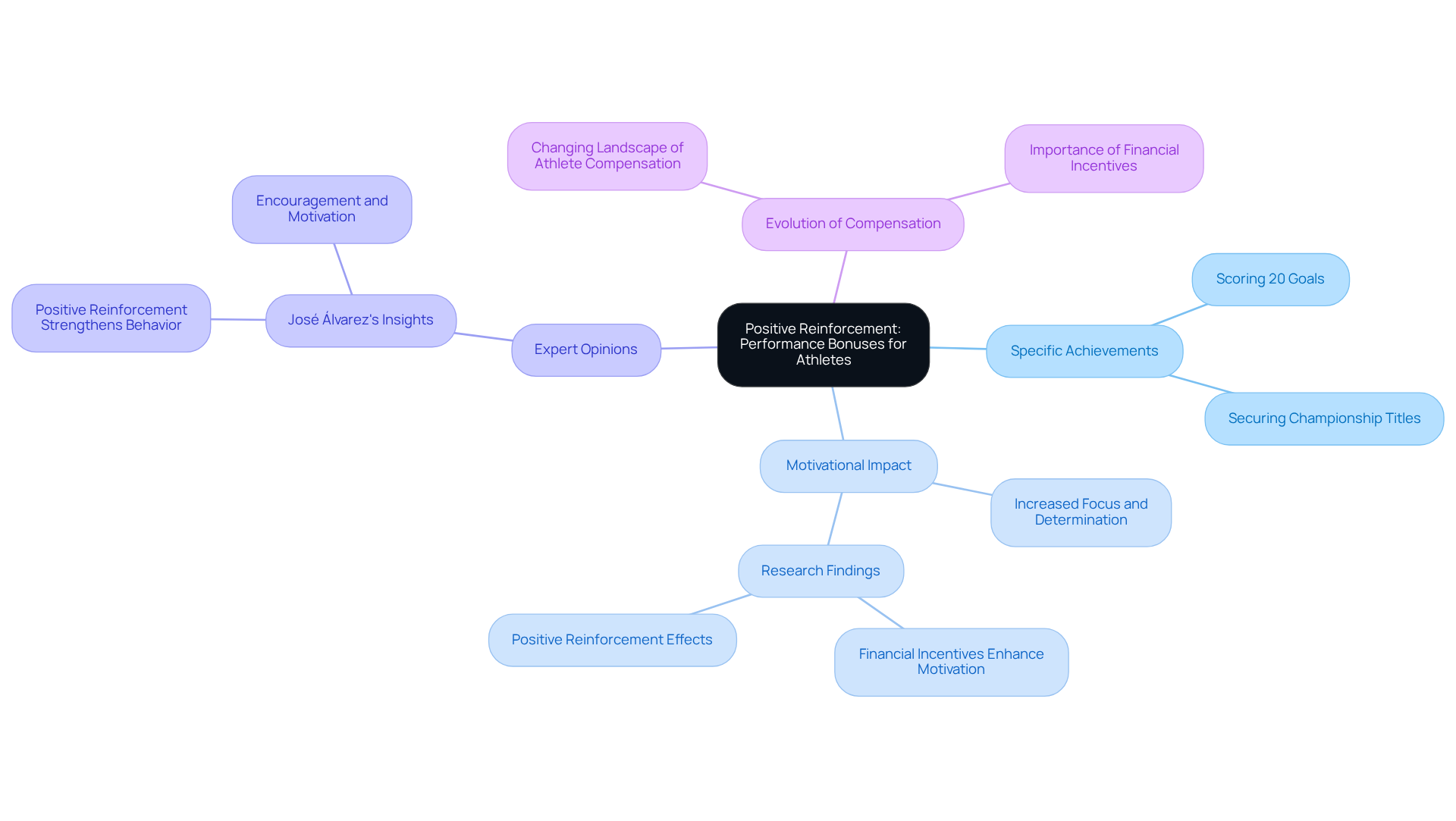
In educational environments, the strategic removal of distractions is one of the positive and negative reinforcement examples that serve as pivotal forms of behavior management. Consider this: when learners exhibit concentration during lessons, using positive and negative reinforcement examples by allowing them to work in a quieter section of the classroom significantly enhances their involvement. This method not only serves as that reinforce their capacity to focus but also stimulates active participation in learning activities.
Recent studies reveal that quiet work areas lead to improved focus and engagement, minimizing external stimuli that often obstruct concentration. Educators have noted that establishing such settings fosters a more supportive atmosphere for learning, ultimately boosting learners' academic performance and overall development.
As educational experts assert, "A good teacher can inspire hope, ignite the imagination, and instill a love of learning," underscoring the necessity of focused learning spaces. Moreover, with cellphone use recognized as a major distraction in classrooms, the implementation of quiet work areas becomes increasingly essential. Political distractions further complicate effective teaching, making it imperative to prioritize environments that bolster student focus and engagement.
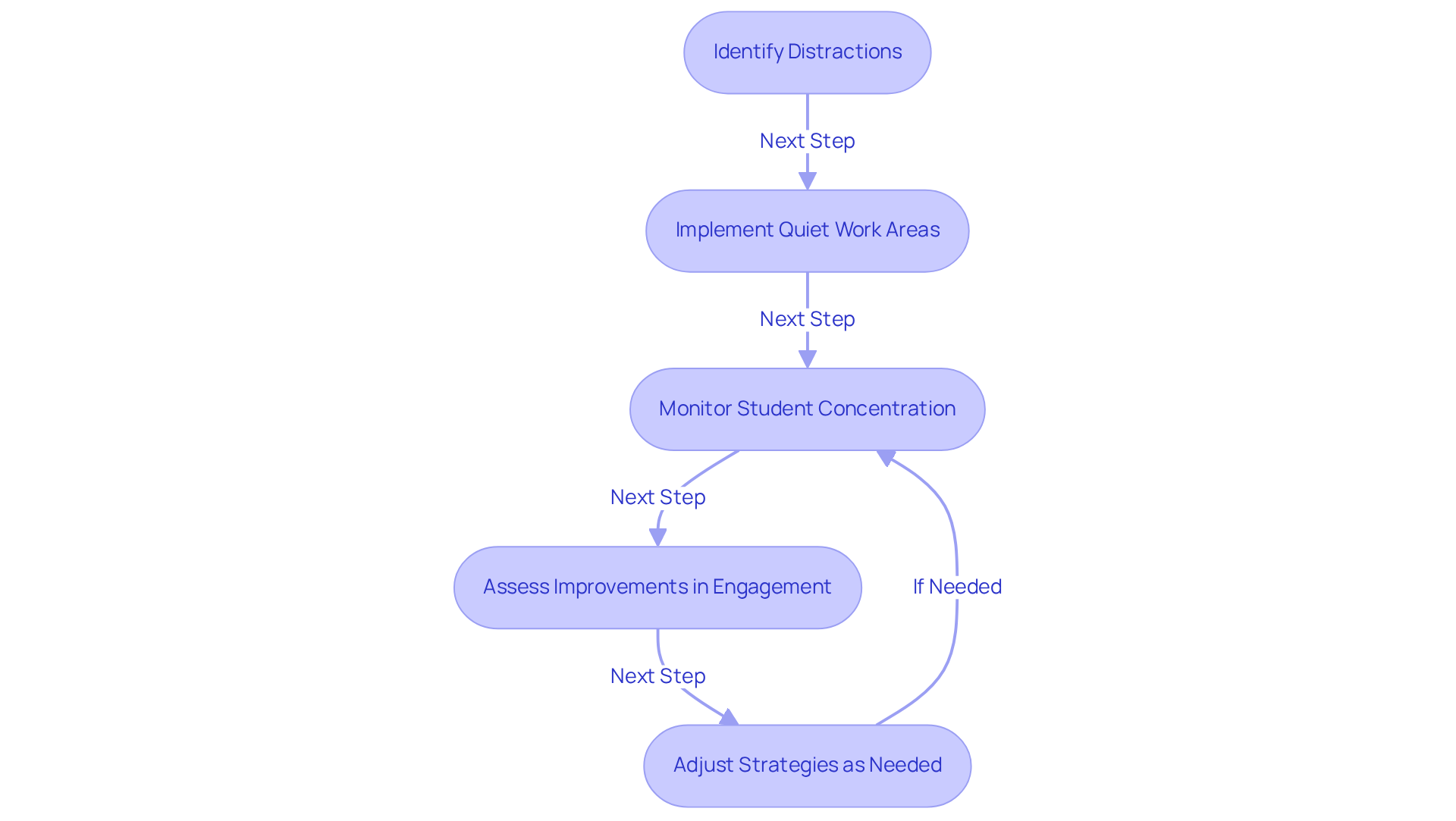
Understanding the influence of both beneficial and adverse stimuli is crucial for . Positive and negative reinforcement examples include introducing a rewarding stimulus to promote desired actions through positive reinforcement, while negative reinforcement enhances behaviors by removing an unpleasant stimulus. Research indicates that these strategies can significantly improve engagement and foster beneficial changes across various environments, including classrooms, homes, and workplaces.
In educational settings, for instance, educators who consistently apply positive reinforcement—such as praise or tangible rewards—have observed enhanced student behavior and motivation. Conversely, negative incentives, such as allowing students to avoid an unpleasant task after demonstrating suitable conduct, can also lead to increased compliance and involvement.
Recent studies underscore the effectiveness of these strategies in diverse contexts. A study on behavior modification methods revealed that educators who effectively utilized incentive approaches reported improved student outcomes. Moreover, behavior analysts emphasize that understanding the consequences of actions is essential; as B.F. Skinner noted, 'Behavior is a function of its results.' This principle underscores the importance of tailoring support strategies to individual needs, ensuring they resonate with the specific behaviors targeted.
Effective examples of incentive strategies, as seen in positive and negative reinforcement examples, include implementing token systems in classrooms, where students earn tokens for positive behaviors that can be exchanged for rewards. In workplace settings, recognizing and rewarding employee achievements can cultivate a culture of motivation and productivity. By thoughtfully leveraging both positive and negative reinforcement, practitioners can create environments that not only promote desired behaviors but also support overall growth and development.
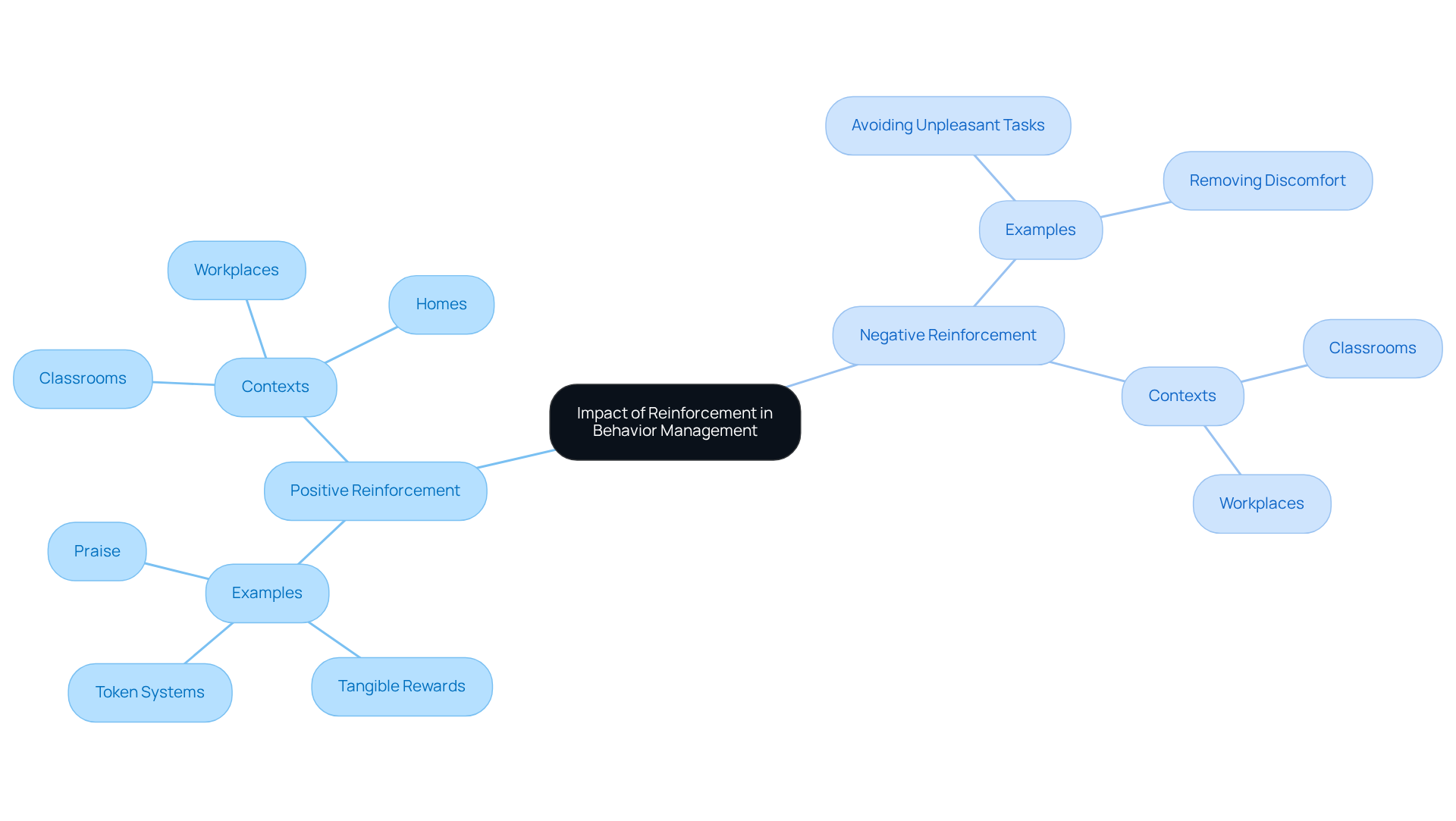
Understanding the dynamics of positive and negative reinforcement is essential for effective behavior management across various settings. By leveraging both types of reinforcement, educators, parents, and employers can create environments that not only promote desired behaviors but also foster overall growth and development.
Key examples illustrate how positive reinforcement, such as praise and token economies, can significantly enhance motivation and engagement. Conversely, negative reinforcement strategies, like escape conditioning and task reduction, demonstrate how removing unpleasant stimuli can lead to improved compliance and reduced disruptive behavior. These insights underscore the importance of tailoring reinforcement strategies to individual needs, ensuring they resonate with the specific behaviors targeted.
The application of these reinforcement techniques can lead to transformative changes in behavior management. By adopting a balanced approach that incorporates both positive and negative reinforcement, stakeholders can cultivate supportive environments that enhance learning, productivity, and overall well-being. Engaging with these concepts empowers individuals and contributes to a culture of success and accountability. Therefore, it is vital for practitioners to implement and adapt these strategies effectively.
What is Hire ABA and how does it benefit Board Certified Behavior Analysts (BCBAs)?
Hire ABA is a platform designed to streamline job matching for Board Certified Behavior Analysts (BCBAs) in a growing job market. It connects candidates with positions suited to their expertise in Applied Behavior Analysis (ABA) therapy, enhancing the job-seeking experience and helping employers find qualified professionals.
What is the projected job market growth for BCBAs?
The demand for BCBAs is expected to grow by approximately 22% to 23% over the next decade, indicating a significant rise in job opportunities within the field.
How does Hire ABA match candidates with job opportunities?
Hire ABA uses personalized resume assessments to evaluate candidates' experience and career goals. It employs advanced job fit scoring to identify opportunities that align with candidates' skills, preferences, and desired locations.
What are token economy systems and how do they work?
Token economy systems are organized reinforcement methods that reward individuals with tokens for exhibiting preferred actions. These tokens can be exchanged for tangible rewards, helping to enhance learner engagement and motivation in educational settings.
What are the benefits of implementing token economy systems?
Well-designed token economies can increase desired behaviors by up to 80% and reduce disruptive incidents by 25-65%. They also help sustain learner engagement, particularly noted during remote learning.
What are some key components for effective implementation of token economies?
Effective token economies require clear expectations, immediate feedback, visual tracking of progress, and examples of positive and negative reinforcement. Customizing the system to meet individual needs is also crucial.
What is escape conditioning and how is it applied in educational settings?
Escape conditioning methods allow individuals to avoid unpleasant situations by engaging in specific actions, such as completing assignments to leave a noisy classroom. This approach reinforces task completion and enhances engagement.
What are some positive and negative reinforcement examples of escape conditioning?
Examples include allowing students to forgo homework for exemplary conduct and silencing disruptive alarms once students have calmed down.
What precautions should be taken when using negative reinforcement techniques?
Caution is advised against excessive reliance on negative reinforcement, as it may lead to avoidance behaviors and unintended consequences. It's important to acknowledge the role of escape in disruptive behaviors among children.
Our expert recruitment strategies and AI-driven sourcing ensure that you receive top-notch candidates quickly, without compromising on quality. Whether you’re looking for BCBAs, Clinical Directors, or RBTs, we’ve got you covered.